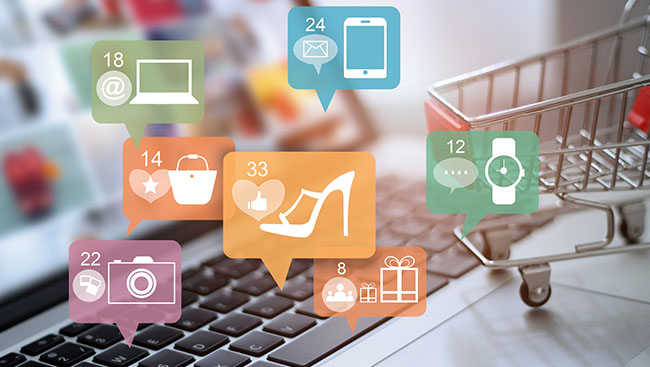With social distancing measures and safety precautions being placed, an increasing number of Canadians are avoiding situations that require them to physically shop at grocery stores and malls.
As the world settles into a new normal, many elements of daily life are undergoing change. With social distancing measures and safety precautions being placed, an increasing number of Canadians are avoiding situations that require them to physically shop at grocery stores and malls. This set of behaviors has had a tremendous impact on the e-commerce industry, where growth has spiked greatly in recent times.
As of mid-April, online U.S. retailers have shown a 68% year-over-year growth. Undoubtedly, much of the growth has also been a result of surge-buying. Based on data released by Statistics Canada, e-commerce sales hit a record $3.9 billion in May, a 2.3% increase over April and 99.3% increase over February. Shopping in stores exposes people to others in an environment that they cannot necessarily control in terms of the cleanliness, number of individuals that have been in the store and the back-end precautions taken while stocking products. In addition, a visit to the store means committing to commute time. On the other hand, shopping online allows for browsing a variety of items without time-pressure, investment in travel time or exposure to a physical environment beyond one’s fingertips. Most platforms relating to online shopping offer no-touch delivery systems, in which the deliverer simply leaves the item(s) at the buyer’s doorstep. E-commerce options also allow an individual to compare product characteristics and pricing amongst retailers to ensure the best possible value.
Given the booming demand of online platforms, the investment being made by e-commerce companies into improving customer experiences is now heightening. These investments are not being made in vain; changing buyer habits are here to stay. According to McKinsey & Company’s latest report regarding the pandemic’s impact on the consumer-packaged goods industry, staying in is the new going out. Even if restrictions are lifted, it is expected that consumers will continue spending more time at home, driven by a desire to save money, persistent safety concerns, and a newfound pleasure in nesting.

The growing prevalence of online shopping also has implications from an employment standpoint. In March, e-commerce giant, Amazon, announced that they would hire 100,000 full-time and part-time hires across their Operations network to keep as many people as possible working during the coronavirus pandemic, and that the company would invest over $350 million globally to increase pay for their teams during the crisis. Especially for those that are vulnerable to being out in public, the dependency on providers like Amazon has increased to a wide extent. This creates unprecedented needs from a labor standpoint.
However, looking at the opposite end of the spectrum, the outlook does not look as strong for retailers that may not have an online presence. Given permanent store closures and some retailers even filing for bankruptcy, the decline in retail workforces could be here to stay. This is not to say that brick and mortar stores are going away anytime soon. Shoppers have formed trust and communities surrounding physical stores, and the convenience aspect of buying a product immediately cannot be matched by online experiences. Browsing for products is much better in person, where consumers can touch and feel items, much likely contributing to why people tend to spend more time physically browsing vs. online.
That said, e-commerce is an undeniable threat to the sustainability of stores that do not offer online alternatives. Traditional brick and mortar stores were already challenged by the daunting shift towards online shopping before the pandemic even hit. After COVID-19, the intensity of this challenge has magnified, making it almost necessary for businesses to have some type of online presence, whether that is in the form of making their products shoppable online, or reaching consumers through digital marketing.
For small businesses, there is a higher risk given constrained resources and limited capability to bear short-term losses. Throughout COVID-19, 92% of small businesses disclosed they were experiencing negative financial effects, with merely 5% stating that they had experienced no effect at all, based on findings from the National Federation of Independent Business (NFIB). Overall, the era of COVID-19 brings extreme levels of uncertainty. There is no guarantee in terms of which side the needle will swing when it comes to shopping habits and for how long. Panic buying and the mentality to follow the crowd to ensure over-preparedness creates a unique situation for businesses that serve consumers directly.
What can be concluded, though, is that the worldwide web will be a preferred destination for shopping. Subscription services, grocery shopping, retail purchases and even window-shopping will see an increase in prominence on e-commerce platforms. The implication for brick and mortar stores is not that of existence, but that of relevance. The key lies in adapting current distribution and marketing strategies to consumer preferences by having some sort of presence in the online world. This will be especially important for businesses of smaller sizes. Regardless, the world is going through major changes and the business universe is undoubtedly going to see the effects. Only time will tell the true impact of this accelerated rate of change on commerce, shaping years to come.

7 E-commerce Tips for Small Businesses:
Chief Revenue and Business Development Officer of software service company, ClickFunnels, Dave Woodward, offers 7 e-commerce tips for small businesses
Don’t let technology be an obstacle.
Get familiar with the options you have and take the time to explore alternatives that are easy-to-use and offer automated solutions.
Build online trust
It is essential to gain customer trust by entering into their realm of awareness online via social media channels, emailed newsletters and other marketing tactics. This will lead to getting that first purchase, following which, things get easier.
Stand out
Make sure your offering is able to offer a unique solution that addresses a specific consumer needs, as compared to competing with the already-prominent alternatives available.
Bundle up
Offer more with complementary products and services.
Lose your single-product mindset
Understand that when a consumer comes to your website, the intention is not to have them buy a single product and leave. Ensure that the website is designed to encourage more purchases.
Build a sales funnel
It is okay to bring in customers with low-priced offers as the value of acquiring a customer who will bring more business exceeds costs at the forefront.
Deliver quickly
Given the competition, customers value fast delivery. This will retain customers and give them another reason to keep ordering from your website.







